REPERTOIRE OF RHETORICAL STRATEGIES TO PRODUCE IDENTITY NARRATIONS THROUGH THE LANGUAGES OF IMAGES
The repertoire of rhetorical strategies was constructed on the basis of the three epistemological dimensions of visual documents (mediatic, compositional, rhetorical), cross-referenced with the types of images: still or video.
STILL IMAGES
As far as still images are concerned, the repertoire mainly takes into consideration the tradition of the artistic portrait and the way it can be appropriated, reworked or subverted on social networks. The artistic portrait genre is defined by three fundamental characteristics on the basis of which it is possible to identify a more or less successful portrait: one which deviates more or less from the classical canon.
The first characteristic is the relationship between the figure and the background. In principle, the background must be neutral – it must not stand out or attract attention, so that the figure placed in front of it may emerge with the right intensity and affirm its presence. However, this configurational nucleus can be applied by artists in many ways, so that a constitutive tension may be built up between the background and the figure, to a point where the figure has to struggle to show itself. A dark background may threaten to engulf a figure partially covered by shade, for instance, or the background and the figure may be characterized by a similar chromatic tone, preventing the full affirmation of the identity in presence.
The second characteristic of the portrait is the compactness and centrality of the figure. The subject represented must constitute a cohesive totality, appearing as an effective condensation of the life path of the subject, ideally capable of coalescing its past, present, and destiny. Even in such a case, the compactness and the centrality of the figure can be put into question or displaced in order to obtain effects such as the fragmentation of the personality or the opacification of the view, for instance by accentuating the provisional character of the subject portrayed.
The third and final characteristic is the lack of action. The subject of the portrait must not be engaged in any activity other than that of resembling him or herself. Any action, forming the germ of a potential narrative, disturbs the subject’s self-directed concentration and the communication of his or her personality to the spectator. The static pose, conceivable as an absence of action that aims to offer something intimate to the gaze of the spectators, is the preferred configuration of the body in portraiture.
A generic structure emerges from these three characteristics: the portrait frontally exhibits a subject offering to view the noblest and most individualized parts of him or herself – the face and the gaze – so as to be completely exposed to the viewer. As explained by art historian Meyer Schapiro, the profile and frontal views in images correspond respectively to the opposition between the he, she or they pronouns and the I/you pair in verbal languages. A gaze directly addressing the spectator configures an I/you relationship, while a scene devoid of any form of addressal produces an impersonal perspective, as if it were unfolding on its own, according to a he, she or it pronominal arrangement. The first conceptualization of this linguistic theory was proposed by linguist Émile Benveniste, and allowed for the construction of the famous dichotomy between historical enunciation, a linguistic utterance characterized by impersonality, and discursive enunciation, where the presence of the I/you pronouns entails the direct addressal of the spectators. The portrait genre normally obeys this second regime of communication, because the subject portrayed, addressing the spectator with his or her gaze, configures a reversible I/you relation.
However, these canons can be tweaked and transgressed in many ways in order to build particular semantic effects. For instance, in the sub-genre of writer portraits, the background is not neutral, but furnished in such a way as to characterize and thematically complete the personality of the figure, usually through the display of books. Stronger variations can be seen in cases where the subject portrayed refuses to meet the viewer with a direct gaze, and may even refuse to show him or herself at all, for example turning his or her back to the camera. Portraiture in painting, especially from the twentieth century onwards, and photographic portraiture abound with cases that destabilize the genre while nevertheless developing on the basis of its rules.
With respect to these characteristics, the identity-related images shared on social networks exhibit a variety of declensions of the portrait genre, some of which follow the canonical model, leading to more or less successful pieces, while others openly transgress its rules in adopting alternative configurations. Following my analysis of Rupi Kaur’s Instagram profile, we can divide the shots into a series of groups, according to their divergence from the ideal type of portraiture.
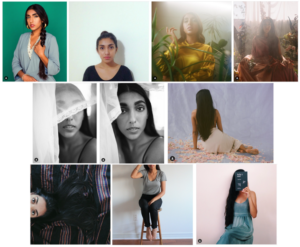
Screenshots of a selection of different portrait types in the work of Rupi Kaur. From left to right: a successful portrait, an imperfect portrait, two atmospheric portraits, two portraits of either discovery or rediscovery, a denied portrait, a portrait fragment, a cropped portrait, a promotional portrait.
A successful portrait (Rupi Kaur, December 23, 2016)
https://www.instagram.com/p/BOVwfKMAk5P/?utm_source=ig_web_copy_link
An imperfect portrait (Rupi Kaur, December 3, 2013)
https://www.instagram.com/p/hchbzPHA0y/?utm_source=ig_web_copy_link
Two atmospheric portraits (Rupi Kaur, October 4, 2017; December 15, 2017)
https://www.instagram.com/p/BZ1AxIEAFup/?utm_source=ig_web_copy_link
https://www.instagram.com/p/BctK-sDAUP6/?utm_source=ig_web_copy_link
Two portraits of either discovery or rediscovery (Rupi Kaur, July 4, 2018; July 8, 2018).
https://www.instagram.com/p/Bkyl0jhAlRo/?utm_source=ig_web_copy_link
https://www.instagram.com/p/Bk85OhSgkYN/?utm_source=ig_web_copy_link
A denied portrait (Rupi Kaur, June 20, 2018)
https://www.instagram.com/p/BkQuBslg_Ck/?utm_source=ig_web_copy_link
A portrait fragment (Rupi Kaur, April 16, 2014)
https://www.instagram.com/p/m3WbDnnA2o/?utm_source=ig_web_copy_link
A cropped portrait (Rupi Kaur, July 25, 2013)
https://www.instagram.com/p/cLKostHA7a/?utm_source=ig_web_copy_link
A promotional portrait (Rupi Kaur, May 15, 2015)
https://www.instagram.com/p/2r0ieInAyp/?utm_source=ig_web_copy_link
This first series of strategies exploits the compositional dimension in order to build peculiar effects of presence and to assert the represented identity figure with more or less force. The strategies found at the intersection between the compositional and rhetorical dimensions in portraits realized through still images are as follows:
1) Cases where a perfect portrait is constructed in accordance with the canons established by the history of pictorial art where the figure depicted is clearly distinguished from the background, is questioningly looking the viewer in the eye, and is not engaged in an action, and where the background either serves to characterize the identity of the individual or is blurred to allow the figure to stand out more (Figure 1).
2) Cases in which the depicted figure’s gaze is denied, either because he or she is overwhelmed by the background and cannot be clearly distinguished from it, or refuses to direct his or her gaze towards the spectator, because there is something that prevents visual contact with the spectator, such as a veil, smoke or other elements, or because he or she turns his back directly to the spectator (Figures 3, 4, 5, 7). The latter strategy can take on different connotations such as an explicit refusal or a casual refusal, for instance because the figure is engaged in another activity and simply ignores the spectator.
3) Cases in which the face is cropped, reproducing some of the most widespread identity image genres on social networks, cropping the face showing only the eyes or, conversely, cropping only the eyes (Figures 8 and 9). This strategy, like the previous one, acquires its full meaning in the context of social networks because it is opposed to other identity-related images that repeatedly show the individual’s face, on multiple occasions.
4) Identity images that exploit devices to focus attention, such as the picture within a picture, the niche, the veil that conceals, the door that directs the gaze, the window that furthers it so as to show other elements (Figures 5 and 6).
5) Images playing with formats, sizes, and especially with the aspect ratio in a manner which increases or decreases the strength of the subject’s presence. The subject can occupy only a small part of the representation space so as to diminish his or her presence (Figure 2), or on the contrary, assert it strongly by occupying it entirely (Figure 1).
6) Using filters or verbal claims to make explicit the alignment of the individual with regard to a social issue (Ukrainian flag, Je Suis Charlie)
7) Cases in which the background is used to thematically complete the identity of the subject represented. This is often seen in the portraits of writers, in which they are usually accompanied by books or portrayed in their studio, and more generally in cases in which the articulation between the figure, background, and environment is capable of associating the identity-idem (physical features) of the individual with the identity-ipse (ethical values). The use of symbols, flags, and effigies are clear examples of this narrative strategy carried out through images, and can be found in painting, photography, in the contemporary political domain, etc.
Identity can be constructed and manipulated through the visual narrations realized by still images also with the help of the rhetorical dimension:
1) The juxtaposition of an identity-related image which constitutes a visual comment on a previous image in order to build effects of visual and semantic reinforcement, of ironic distancing or of protest, as in the case of influencer Celeste Barber. In this image, two strategies are employed by which the compositional dimension is made to be correlated with the rhetorical one:
a) Compositionally, the pose and figure depicted are similar. In both cases, it is a woman, dressed in a summery outfit, intent on drinking. However, the decisive difference is that the first image constructs an effect of freshness and sensuality, whereas the second builds an effect of comic self-mockery, of embarrassment.
b) However, it is not simply an image that comments ironically on the first one, because another reading may be more appropriate. The influencer, by embarrassing herself for not being able to carry out the sexy pose, and hitting her face with the jet of water, also reinterprets the first image as somewhat ridiculous, in that it emphasizes the ideological and sexist values contained in the first image: the gratuitously exposed sensuality, the body put on display, and the partial objectification of the female figure. In other words, the comment realized through the second image builds an effect of seriality in which the exposure of the body is submitted to several degrees of mistreatment and ridicule, ranging from the forced sensual exposure (first fashion photo) to the embarrassment and inadequacy of being in a similar situation (influencer photo).
c) The identity gap is realized as much: i) by the mise-en-scène, which plays at building an ironic resemblance, using the same technical format (black and white, the same size and shape of the two images); ii) at the rhetorical level, since the first image is an image produced within the fashion domain, while the second is an original production typical of social networks, which we would struggle to define if not by appealing to the formula of an identity-related image.

One of the visual comments made by Celeste Barber on her Instagram page: https://www.instagram.com/p/BjjbOQBhENO/
2) The insertion of an identity image that complies precisely with generic canons (e.g. of fashion, of art) into a different context. A typical example of how images can exploit attested genres is the artistic work of Cindy Sherman, whose production is characterized by a series of self-portraits in which genres from the past, which are highly socially normalized, add a wealth of visual and cultural motifs to her figure, exploiting the languages of the image and their historical depth. In the second image, in particular, it is not only the rhetorical dimension, in accordance with a period portrait, that is exploited, but also the mediatic dimension, which imitates both a photographic format and an aura of the past.
Two portraits by Cindy Sherman:
https://api.time.com/wp-content/uploads/2012/02/cindysherman_05.jpg
https://blog.qagoma.qld.gov.au/wp-content/media/BLOG_SHERMANcindy_CS540.jpg
3) An identity-related image accompanied by a verbal discourse that is socially or politically committed to a specific issue. This is the case with Rupi Kaur’s republication of her controversial image from the periodseries: she attests to her identity by articulating her physical features but also her values and her ethical orientation.
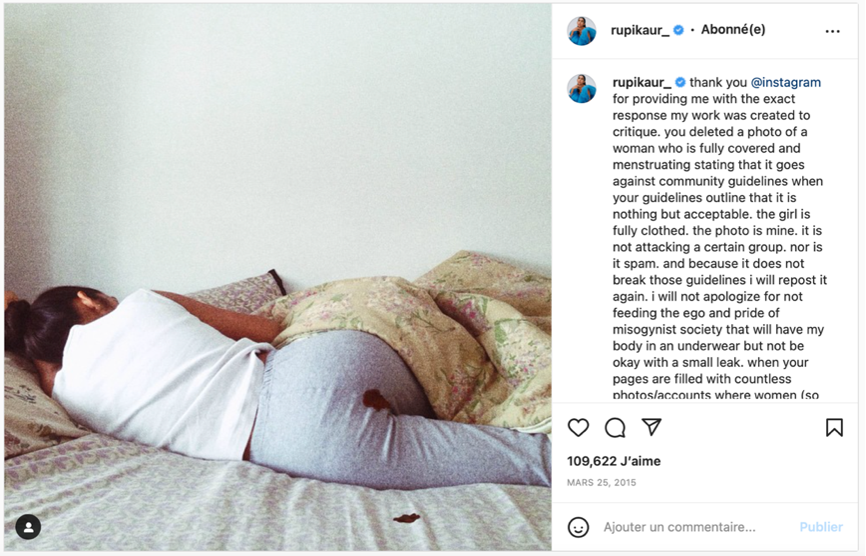
A screenshot of an image from the period series posted again by Rupi Kaur on her profile along with a verbal protest against censorship by Instagram: https://www.instagram.com/p/0ovWwJHA6f/
Identity narrations in still images articulated through the mediatic dimension:
1) Adding an aura of the past to an identity-related image, projecting the identity of the individual onto another historical and social context through the technical format of the image. This may also be seen in the work of Cindy Sherman, who not only uses an image that imitates a camera from the past, but also follows consistent aesthetic dress norms.
2) Using a different substance of expression, such as an animated drawing, to build a semantic break with other images posted by the same individual on their social channels and to achieve a fictionalizing effect. Below is an image taken from Aiden Animation’s YouTube channel. This is an image taken from a video, but the same strategy can be used in still images.
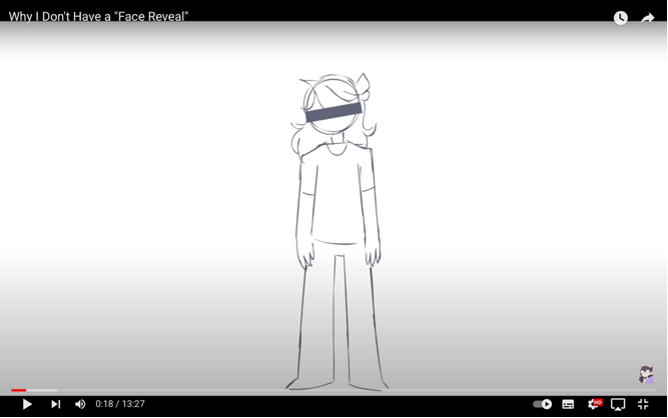
A screenshot from Aiden Animation’s face reveal video (https://www.youtube.com/watch?v=VhEATqXnXCI)
The analysis of Gerhard Richter’s artistic production has made it possible to find two further strategies that are characterized by a more complex construction:
1) Building a perceptual ‘pre-thought’, which anticipates the categorizations of verbal language, in order to interrogate the temporality of the gaze normally fueled by the technical and semiotic habits of an era. For example: using aged photographic formats in order to build a visual effect evoking the past (e.g. polaroid, photo printed on newspaper).
Two of Richter’s artworks that show the dialogue with photography realized through technical formats: Familie Ficher (https://www.gerhard-richter.com/datadir/images_new/xxlarge/2740.jpg)
and Mutter und Tochter (https://www.gerhard-richter.com/datadir/images_new/xxlarge/2544.jpg)
2) Organizing the composition of the image by imitating the composition of different genres originating from dissonant domains (advertising, press ad, tourist image).
Two paintings by Richter:
Familie (https://www.gerhard-richter.com/datadir/images_new/xxlarge/2459.jpg)
and Motorboot (https://www.gerhard-richter.com/datadir/images_new/xxlarge/9119.jpg)
VIDEO PRODUCTIONS
With regard to the rhetorical strategies identified with respect to video productions, the corpus that has been analyzed as a whole consists of the following works:
Forgotten Silver (1995, Peter Jackson, Costa Botes)
Grizzly Man (2005, Werner Herzog)
Holy Motors (2012, Leos Carax)
Waltz with Bashir (2008, Ari Folman)
The Congress (2013, Ari Folman)
The Act of Killing (2012, Joshua Oppenheimer)
The Look of Silence (2014, Joshua Oppenheimer)
Repulsion (1965, Roman Polanski)
I Am Not Your Negro (2016, Raoul Peck)
The Wild Blue Yonder (2005, Werner Herzog)
Redacted (2007, Brian De Palma)
Narcos (2015 – 2017, Netflix)
Trumbo (2015, Jay Roach)
Homecoming (2018, Amazon Prime Video)
Mommy (2014, Xavier Dolan)
Rhetorical strategies which exploit a dominant mediatic dimension
1. Creating an alternative foundational narrative, as in the case of Forgotten Silver, which uses a fake documentary to present a precursor of New Zealand cinema that never actually existed. This strategy is achieved by simulating the technical camera formats of the origins of cinema and, more generally, their evolution over the first part of the nascent cinematographic art. Images that simulate archival formats are alternated with images of the discovery of the films, which are made according to the technical standards of the 1990s. This gap helps to articulate the temporal dimension between past and present and to build a reality effect.
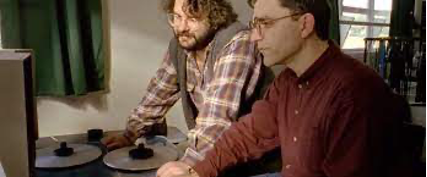
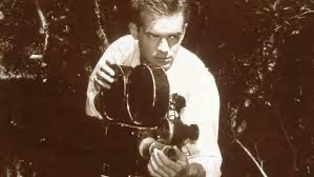
Two screenshots from Forgotten Silver
2. Constructing enigmatic references through particular genre productions, as in the case of Holy Motors by Leos Carax. The film appropriates images from an archive of chronophotographic footage and mixes them with an alternative fictional universe in which cinema consists of actorly performances sequenced without the encounter with the crew and cinematographic production apparatus we all know. It is thus the very identity of the professionals of fiction, as well as of cinema as a whole, that is questioned through an enigmatic identity narration.

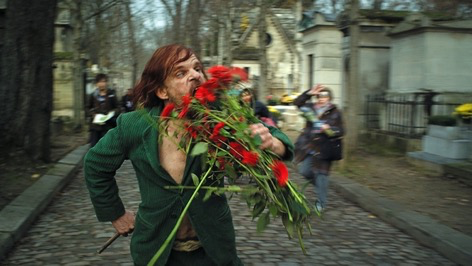
Two screenshots from Holy Motors
2) Constructing gaps between genres of belief regimes on the one hand, and substances of expression and technical formats on the other. This is the case in Waltz with Bashir by Ari Folman, which is characterized by the use of two different strategies: 1) A break, at the level of the substances of expression, from an established film genre. The film uses the cartoon technique while associating it with a documentary devoted to a massacre. This is a deviation from cultural norms, because this kind of production is usually realized through the photographic image; 2) A second deviation occurs at the end of the film, when archival photographic images are inserted to show the consequences of the massacre. This second deviation from animated images to photographic images contributes to the construction of a reality effect and makes the images of the event more effective than they would be, for instance, had they been presented without expressive deviations into a television news broadcast.

A series of screenshots from Waltz with Bashir
3) Exploiting the gap between substances of expression and technical formats in order to build effects of estrangement and effects of reality, as in the case of The Congress by Ari Folman. As in the previous film, it is a question of inserting real elements, in this case, actress Robin Wright playing herself in order to narratively transform her identity. The fictional narration takes advantage of certain changes at the level of the substances of expression. The transition from photographic substance to animated substance occurs several times and it is used to articulate on a narrative level the construction of a science-fictional universe stemming from a realistic basis.

A series of screenshots from The Congress
4) Imitating or simulating the technical format of a particular device (e.g. images from early cinema or from surveillance cameras) in order to present an event exploiting reality effects of meaning, as in the case of Redacted by Brian De Palma. This is a film that focuses on a case of sexual violence perpetrated during the Iraq war by US soldiers. The film relies on footage from smartphones, surveillance cameras, and web videos. However, these videos are not the actual available footage of the event, but sequences specially shot by De Palma imitating their technical formats and compositional style. This strategy builds an interrogation of the truth value of the images and the perceptual norms associated with each technical format.
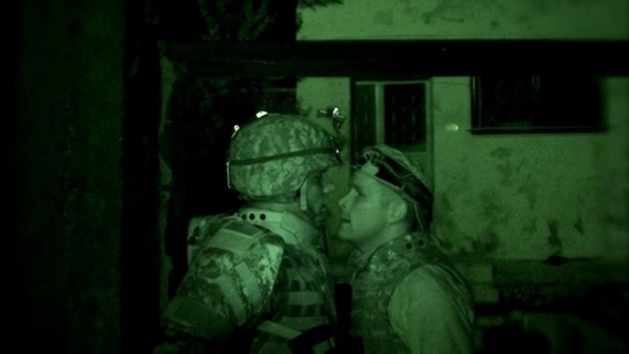
A screenshot from Redacted
5) Simulating a technical format of the past and building an effect of temporal sedimentation with the technical formats of the present, as in the case of Trumbo. This is a biographical film that traces the life, especially within the US film industry, of screenwriter Dalton Trumbo. The historical characters are played by actors, but are alternated with archive sequences. Rather than simply presenting the gap between technical formats of the past and of the present (as in the case of the Narcos series, which uses these gaps in order to build to an effect of historical validation), Trumbo presents sequences in which archive footage is gradually transformed into modern footage, inserting the identity-related performances of
contemporary actors into the original context.
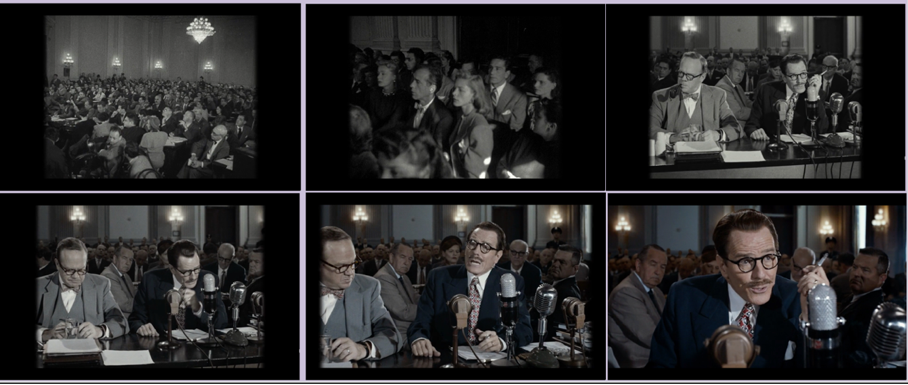
A sequence from the film Trumbo

Two screenshots from the Narcos series
Compositional dominant
1) Using a particular montage of images juxtaposed with written or oral verbal comments in order to build a narration that transforms an individual’s identity. This is a very flexible strategy. In Werner Herzog’s documentary Grizzly Man, he builds an identity narration about Timothy Treadwell, an enthusiastic bear lover who died tragically with his partner, attacked by his favorite animals. Herzog collects the footage filmed by Timothy and makes a profound use of archival appropriation in which the figure is commented on, criticized, and celebrated through an archival montage of the original footage produced by Timothy and of the witnesses collected by Herzog himself. The relationship between archival images and commentary images contributes to the creation of a deep identity narration capable of harmonizing the physical identity (idem) to ethical values (ipse).

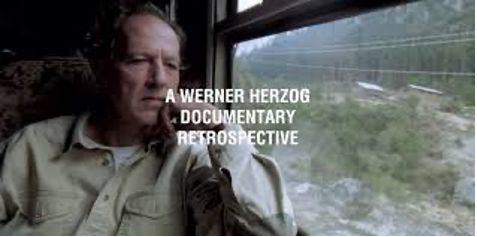
Two screenshots from Grizzly Man
2) Playing with the aspect ratio of images, e.g. by extending a 4:3 format to make it panoramic, in order to emphasize certain events such as the opening up of perspectives on life by an actor or character, or the sudden understanding of events, as in the cases of Xavier Dolan’s Mommy or of the Homecoming series. The aspect ratio of the images abandons its exclusively technical role to become a compositional pivot to the identity narration.
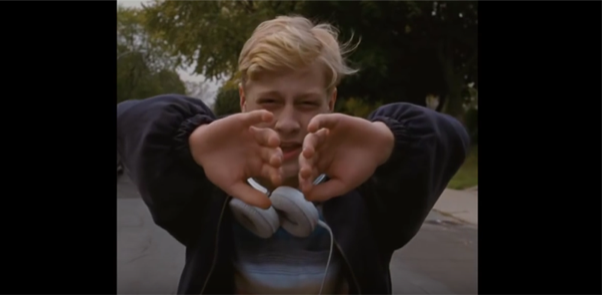
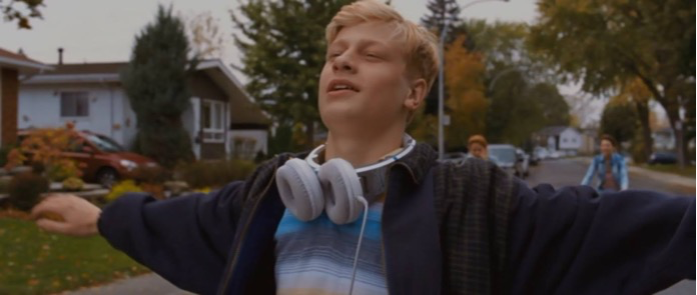
Two screenshots from Mommy
Rhetorical dominant
1) Exploiting the storytelling genres of Hollywood cinema (westerns, gangster movies) to stage historical events characterized by a different semantic tonality or to show tragic events, in order to build effects of emotional distancing, of estrangement, or of creepiness, as in the case of Joshua Oppenheimer’s The Act of Killing. This documentary not only lets the perpetrators of the genocide in the 1960s of alleged communists in Indonesia speak, but asks them to film the killings in which they seem to take pride. Anwar Congo, one of the perpetrators of the killings, chooses the canons of the western and gangster cinematic genres. But by physically putting himself in the victim’s place during the act, he feels the weight of guilt and has an illness that triggers repentance.

Two screenshots taken from The Act of Killing
2) Using a voice-over to build a fictional narration superimposed over video or photographic images, as in the case of the documentary The Wild Blue Yonder by Werner Herzog. In this science fiction film, Herzog exclusively uses archival images from the documentary genre. Footage of unusual places on planet earth is reinterpreted as representing a space journey made by an alien following the canons of the science fiction genre. In this way, the languages of images are able to renew a well-known setting, our own planet, with a mysterious and alienating aura, thanks to an identity narration capable of enhancing the variety of landscapes that constitute it, and forcing the spectator to assume a new, fresh gaze.
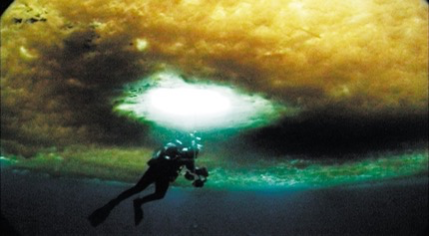

Two screenshots taken from The Wild Blue Yonder
3) Showing a particular viewer in the act of watching a set of archival images related to events that profoundly affect him or her. This is the case in The Look of Silence by Joshua Oppenheimer. The documentary shows an individual from Indonesia, who remained anonymous, who suffered the murder of relatives in the 1960s as a result of mass killings. The film shows this same individual watching footage of the executioners gladly describing the killings. In other sequences, he directly interrogates the executioners under the eye of the cameras. The position of the victim in front of the archival images is able to direct the gaze of the viewer who empathizes with him. In this way, a complex identity narration is achieved: the identity of the executioners, celebrated as national heroes, is called into question, just as the identity of the victims and their power of action are called into question. And ultimately, the
historical and ethical identity of the nation as a whole is challenged.

Two screenshots taken from The Look of Silence
4) Inserting a significant picture that allows one to reinterpret in another way what is stated in an audiovisual discourse, as in the case of Repulsion by Roman Polanski. In this fictional film, the protagonist Carol undergoes a slow process of dissociation in which, as a result of advances by different men, she begins to hallucinate and carries out a murder. The viewer understands the reasons for this dissociation only at the end of the film, when a family photo is foregrounded in the frame, with the camera zooming in on the speechless face of Carol as a child, unequivocally suggesting a violence suffered in the family context. The revelation, entrusted to a single still image within a feature-length film, allows for a profound reinterpretation of the events and builds a strong effect of intensity.

A screenshot from the final sequence of Repulsion
The documentary I Am Not Your Negro, made by Raoul Peck in order to denounce the treatment of Afro-descendants in the United States of America, makes use of different strategies of identity narration realized through archival editing:
a) The contrasting of images of mythical figures of the Hollywood tradition, such as images of film divas, with gory images of the treatment suffered by Afro-descendants. These two groups of images were contrasted on the basis of compositional similarities while differing sharply in terms of the themes, identities represented, emotional tone, and the rhetorical genres to which they belong. The rhetorical strategy consists in building an opposition between two identity narrations characterized by a profound thematic gap. The result is the achievement of reciprocal identity-related effects of meaning: the Hollywood images are reinterpreted as hypocritical and creepy, while the Afro-descendant images foster an effect of indignation and unacceptability.

Two screenshots taken from I Am Not Your Negro
b) The mediatic dimension making it possible to highlight similar themes but within images produced in different eras. Black and white images picturing protests from the 1950s are juxtaposed with contemporary high-definition color images. In this way, the audiovisual text exposes the occurrence of analogous events and conflicts taking place in different eras, and is able to build a narration about an ethnic identity as it has developed throughout history, denouncing the fact that despite the passage of decades, the situation has not changed.
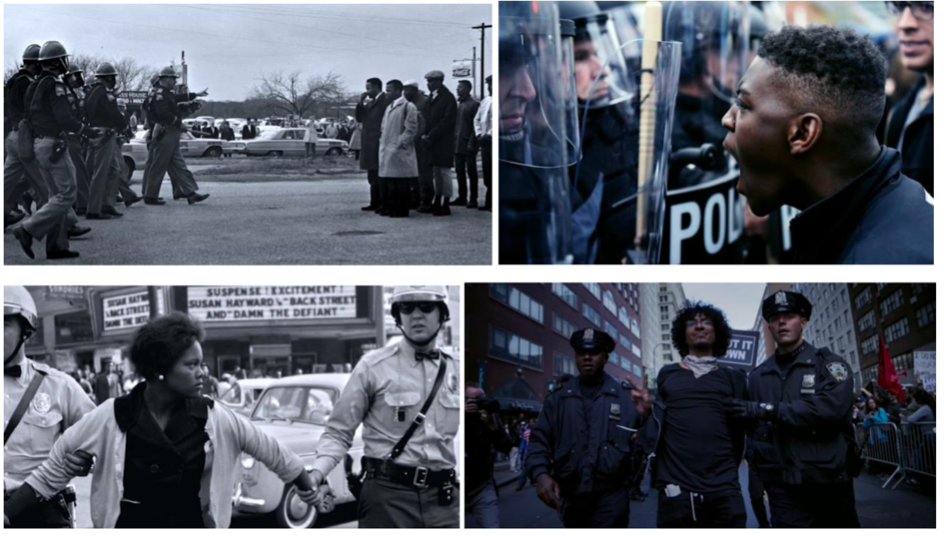
Two screenshots taken from I Am Not Your Negro